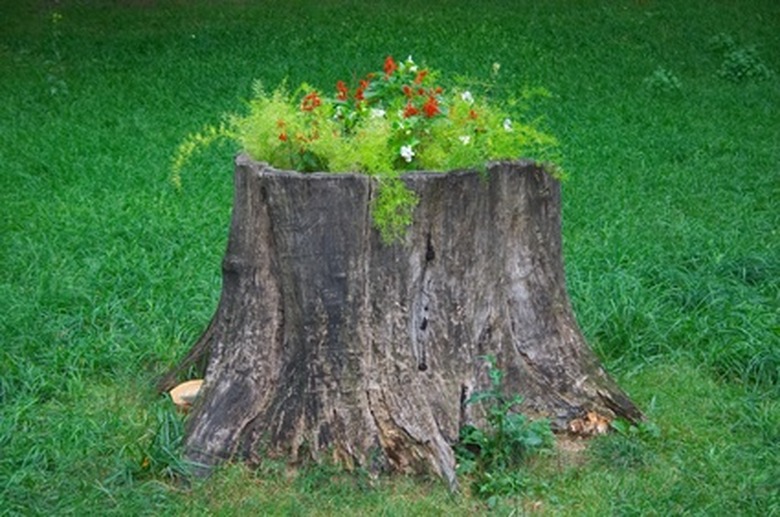How To Cut Stumps With A Chainsaw
Things Needed
- Shovel
- Rake
- Hatchet
- Safety goggles
- Cut-proof safety gloves
- Chainsaw
- Felling wedges, plastic or wood
- Mallet
- Crowbar
- Extra saw chain
- Chainsaw bar tool
When felling trees, most professional sawyers, as well as home handymen leave a noticeable stump behind. A stump 2 or more feet high allows enough room to form the felling notches and precise cuts that control the direction of the tree's fall. After the tree hits the ground the stump could be safely reduced in height to 1 inch or less above ground level. Cutting stumps that short requires special tools and precautions, and may ruin a good saw chain unless you are careful.
Step 1
Clear the area around the stump, removing any debris which could interfere with the movement of the saw. Since the operator will kneel near the stump to work, pay attention to sharp objects embedded in the ground. Pound them down or dig them out.
- When felling trees, most professional sawyers, as well as home handymen leave a noticeable stump behind.
- Since the operator will kneel near the stump to work, pay attention to sharp objects embedded in the ground.
Step 2
Dig out any uneven patches of dirt around the stump. Create a flat space of cleared dirt wide enough to allow good access on all sides of the stump.
Step 3
Get down on the ground and lay the chainsaw beside the stump in cutting position. Place the bar against the stump and sight along it to spot any debris or other obstructions in the line of the cut. Remove them.
Step 4
Clear away any bark or wood with dirt on it. Chop the soiled surfaces away with the hatchet until clean wood shows. Don't cut through wood with grit or clay on the surface, since dirt ruins the saw chain's cutting edge.
- Dig out any uneven patches of dirt around the stump.
- Create a flat space of cleared dirt wide enough to allow good access on all sides of the stump.
Step 5
Cut just high enough on the stump that the motor housing clears the ground. With many chainsaws the lowest working level will be just under an inch above ground level.
Step 6
Insert wedges into the cut to support large stumps as the blade passes the halfway point. Without wedges for support, the heavy stump will fall on the blade. With small stumps there's no room or need for wedges.
Step 7
Stop the saw 2 or 3 inches from the edge of the stump and back it out of the cut. Knock out the wedges and finish the cut from the opposite side.
- Cut just high enough on the stump that the motor housing clears the ground.
- Knock out the wedges and finish the cut from the opposite side.
Tip
Safe cutting diameter for most homeowner-quality chainsaws equals half the bar length. Embedding the full length of a chainsaw bar in the cut greatly increases the chances the saw will kick back. Don't tackle a 2 foot diameter stump with a 16-inch chainsaw bar. Only properly sharpened and correctly tensioned saw chains cut without wandering. Do the maintenance before starting the cut. Never use steel wedges to keep a cut open. Plastic or wooden felling wedges support the load without damaging the saw chain.
Warning
Professionals leave tall stumps for good reasons. The lower section of a tree could enclose many types of debris from rocks to steel spikes. Cutting into hard objects embedded in the wood could break a saw chain and cause the operator serious injury. Consider alternatives like chemical rot accelerators. Allowing stumps to rot naturally provides the safest removal. Removing stumps to below ground level requires special grinding machines with cutting bits impervious to damage from rocks and dirt.
